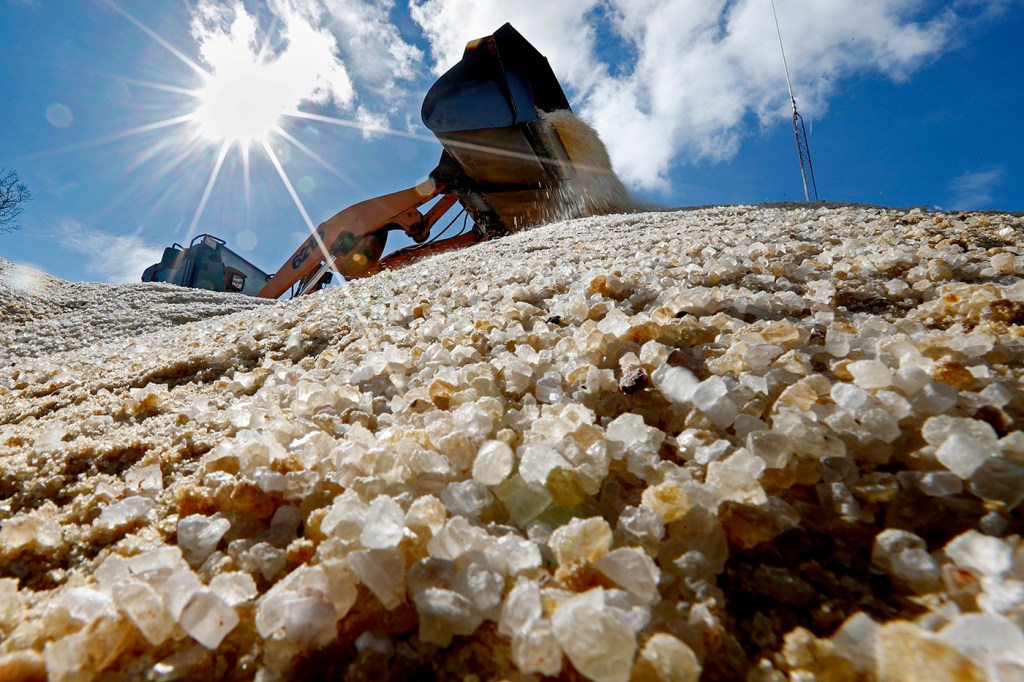Contaminated water in New York state could endanger half a million people. The culprit is road salt.

In a tiny community along the St. Lawrence River in New York, people’s dishwashers were breaking down. The metal interiors were corroded, their surfaces pock-marked with white.
Residents had no way of knowing what was wrong, but watching appliances break down was enough to stoke fear about the water that ran through them.

Kelsey Pieper, assistant professor of civil and environmental engineering, helped uncover sources of water contamination in Flint, Michigan, leading her to more recent work in New York, New Jersey, and Puerto Rico. Photo by Billie Weiss for Northeastern University
Kelsey Pieper was part of the search for a cause, uncovering the bitter truth: salt. Her previous work in Flint, Michigan, exposed her to how corrosive the chloride in salt can be, and how, in some cases, it led to lead contamination. Now Pieper, assistant professor of civil and environmental engineering at Northeastern, wants others, too, to know what’s in their water, putting tools into the hands of people from New Jersey to Puerto Rico.
Pieper was working at Virginia Tech when she heard from a resident of Fisher’s Landing, a community of 89 people tucked into the crook of northwestern New York.
This resident had read that chloride was partly to blame for lead contamination in Flint, a finding that came out of Pieper’s work with Marc Edwards and other researchers, and was worried the same might be true in Fisher’s Landing, where the resident had seen high lead levels on her property and others had seen high chloride levels on theirs. It was also where people lived in close proximity to a Department of Transportation facility full of the salt used to treat roads—a compound that’s one half chloride.
“They think it’s from the road salt,” Pieper recalls thinking. “But is there a way that we can definitively prove this?”
The team offered to test the water for free, and the results showed that chloride levels were highest in the places closest to where the salt was stored. Additionally, one in five homes used water that exceeded the Environmental Protection Agency’s limit not only for chloride, but for lead or copper as well. And as Pieper and her co-authors showed in follow-up lab experiments, when water has high enough levels of chloride, it corrodes lead solder joints.
Since high chloride levels can be a warning sign of lead to come (or lead that did come but went unnoticed), Pieper, Edwards, and Rebecca Kriss, a Virginia Tech doctoral student, are working to improve at-home lead-detection tools, distributing them to residents of Newark, New Jersey, and assessing whether they work better than standard detection kits.
These kits, which work a lot like stick pregnancy tests, miss larger particles of lead and can therefore turn up erroneously low contamination levels. But Kriss devised a workaround: “She came up with a method using lemon juice to do an at-home digestion,” says Pieper. With the help of this household item, lead can be better integrated into and detected in the liquid.
“There’s so much more need to get testing done and better understand lead in drinking water throughout the United States,” Pieper says, “in particular in Puerto Rico.” To that end, Pieper also recently sent kits to the island to assess water quality. This work is through a Northeastern research center, directed by Akram Alshawabkeh, dedicated to understanding contamination threats in Puerto Rico.
While comprehensive solutions are proving necessary in some parts of the United States, in others, a problem with lead can stem from a seemingly simple source: road salt, which New York uses more of than any other state.
Residents of Fisher’s Landing were uniquely vulnerable to salt because of their small-town proximity to where it was stored and their reliance on unregulated wells, but other people throughout the state are vulnerable, too. As part of their research, Pieper and her fellow researchers estimated that a similar risk could be faced by other private well users in New York—some 495,000 of them.
To the majority of U.S. residents, whose water comes from public sources and is regulated under the Safe Drinking Water Act, salt-saturated water shouldn’t be a problem: The EPA requires municipal workers to meet its water quality standards, so not only should contaminants in public water not exceed unsafe levels, but it shouldn’t fall on consumers to notice.
But people who get their water from private wells, natural springs, or cisterns don’t have that luxury—that’s an estimated 47 million Americans, says Pieper, which is “based on the 1990 census—that’s how limited our understanding is of this population.”
“We turn on the tap; we expect water to come out,” Pieper says. “Well, when you’re on a private well, there are steps that you need to do to make sure your water is safe.”
Like in Flint’s prominent battle against unsafe water, which is still ongoing, residents are often the ones drawing attention to contamination, harkening back to the Schroeder family that suspected trouble in Love Canal or the farmer living downstream from DuPont’s chemical landfill. But like those of Fisher’s Landing, residents throughout the United States did and may continue to benefit from the help of Pieper and her colleagues.
“Residents are engaged, they’re knowledgeable about these systems, and they can play a very important part,” says Pieper. “We need to provide them better tools, better resources, so they can better protect themselves.”
For media inquiries, please contact Jessica Hair at j.hair@northeastern.edu or 617-373-5718.





